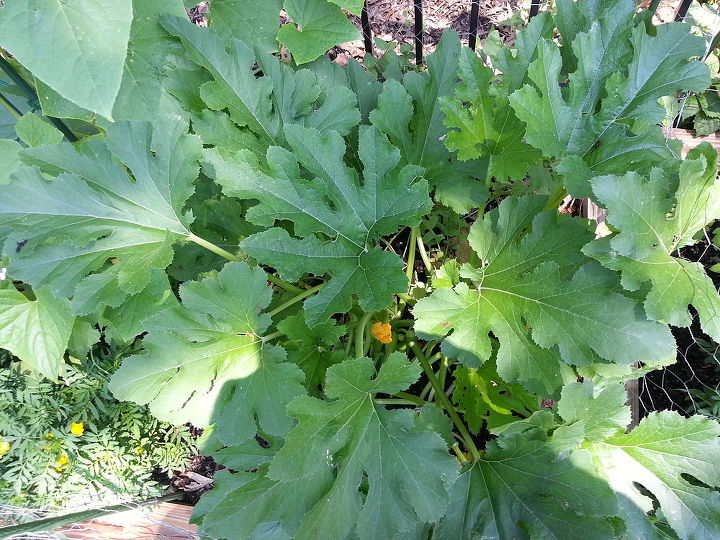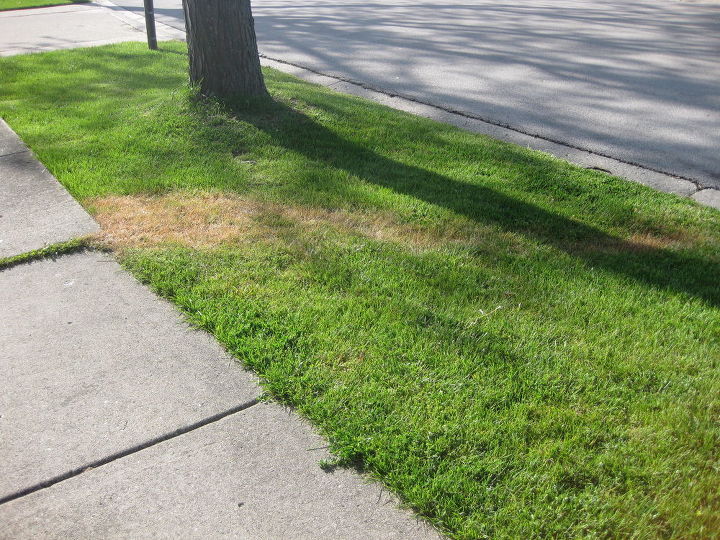I have a west facing back yard (1/4 acre) reseed every fall w/ quality seed. Way too many weeds in fall/winter

-
Are you re-seeding with fescue? How much light does the area get? Are you tilling before seeding?
 Walter Reeves
on Jan 22, 2012
Helpful Reply
Walter Reeves
on Jan 22, 2012
Helpful Reply -
-
I am using a blend of fescue and bluegrass. Water is available I am Using an aerator and a rake pulled behind my mower. The area gets 8 hours or so of light but intense afternoon sun in the summer
 Jimmy
on Jan 22, 2012
Helpful Reply
Jimmy
on Jan 22, 2012
Helpful Reply -
-
The intense sun can be a killer if the fescue/bluegrass roots are not deep. That's why tilling beforehand is so important.
 Walter Reeves
on Jan 23, 2012
Helpful Reply
Walter Reeves
on Jan 23, 2012
Helpful Reply -
-
Thanks for the answers, but I'm still hoping for more ideas.
 Jimmy
on Jan 27, 2012
Helpful Reply
Jimmy
on Jan 27, 2012
Helpful Reply -
-
You may not like it but there is a Peanut Grass that I recently saw in several of my neighbors yards that grows fast, looks nice and doesn't require a lot of work. Most of us have St Augustine grass and it is a full time job. This peanut grass is new to my neighborhood. It has pretty yellow flowers.
 Sherrie S
on Jan 27, 2012
Helpful Reply
Sherrie S
on Jan 27, 2012
Helpful Reply- See 1 previous
-
-
I don't know what you are using to treat your lawn but weeds become resistant to chemical treatments over time. To be honest, we always let our back lawn (previous house in an HOA) just grow. Many 'weeds' are beneficial to both our soil and our native pollinators. Anyway, be sure not to mow too short. Keep your blades at 3 1/2 to 4 inches high. Longer grass actually deters weeds, keeps the grass roots cooler in hot weather, and needs less water overall. This will help to discourage weeds as they will have a harder time getting to the soil through the longer grass.
 Kathy Ruth
on Jun 22, 2015
Helpful Reply
Kathy Ruth
on Jun 22, 2015
Helpful Reply -
-
All grass seed has a small amount of weed seed in it. You are actually planting the weeds as well as the grass. I would try a weed and feed product. Make sure you water well all summer to keep your fescue from going dormant as it does not like heat. Your blue grass is a slower growing grass that does like heat and requires less water, it may not appear until next year.
 Tonia
on Jun 22, 2015
Helpful Reply
Tonia
on Jun 22, 2015
Helpful Reply -
-
When we bought our house 22yrs. ago, the front and back yard were mostly packed dirt and weeds. We found out that 15" under the dirt is cliché. Knowing this, we decided to spend a little extra on grass seed and planted a native grass called buffalo grass. It only grows about 4-6" tall with seed heads at 6-8". We use a mulch mower and water only when needed. Every time we mow we are reseeding our lawn. In 2 yrs. all the dirt was covered with grass. It grows thick and chokes out goat-head stickers and weeds. Because it covers so completely, we don't have to worry about weed. We have been in a drought for several years (until this year) and we didn't water the lawn very often ( we have a well). This grass is so green and thick this year because of the rain, and we have to mow every 4th day because of the seed heads. It has been the very best investment we could have ever made. I have the best looking lawn on the block and people often ask me what kind of grass I have. So, my advise is to always invest in a native grass to the area you live in. In drought seasons my grass goes dormant, but does not die, if it doesn't get watered. "Quality grass seed" is a term used by those wanting to sell you seed. Ask you local County Ag office what their recommendation for a native grass to plant.
 Wanda Arganbright
on Jun 22, 2015
Helpful Reply
Wanda Arganbright
on Jun 22, 2015
Helpful Reply -
-
I'm a Missouri Master Gardener and don't know a lot about NC's climate, but this is how a Master Gardener would do it. Since this is June, I'm guessing your "lawn" doesn't look too good, so you'll probably have to just put up with it for the summer. Bluegrass and fescue are cool season grasses and are best seeded in early September to take advantage of the cooler weather and fall rains, plus the still warm ground to germinate the seed. Spray down the weeds about mid-August to give the chemical time to work, mow VERY low (catch the clippings) the morning you are ready to seed (I would recommend Labor Day weekend). It is up to you if you also want to aerate and/or verticut before seeding, but if you don't, at least rake through the vegetation that is there, especially any bare spots, to scratch up the soil to get good seed-to-soil contact. (You can rent the equipment from Home Depot or a local rental place if you aerate/verticut.) Overseed HEAVILY and water at least twice a day, maybe three times if we get a late summer heat wave. Put down a seed starter lawn fertilizer with the grass seed so that it is watered in well and ready to feed the grass when it sprouts in about 10 - 14 days and cover the seed/fertilizer with a thin layer of peat moss to hold moisture in. Keep the emerging grass damp for another 10 days or so with daily watering, then cut back to every other day, then every three-four days depending on the weather, temperature, etc. Do your first mowing when the new grass is 3" high or so and after the third mowing fertilize again with a fall weed and feed. (It should be about the second week of October by now.) Continue mowing (and watering) as needed and fertilize again with a winterizer type fertilizer around Thanksgiving. Water every fertilizing in well if there isn't rain and keep an eye on the lawn during the winter. If you don't get snowcover (I have no idea about NC winters), you may need to water a time or two during the winter if the ground seems dry. Fertilize with a good quality lawn fertilizer/crabgrass pre-emergent about the middle of March, first of April or so. I don't recommend a May fertilizing (which Scott's wants us to do) unless you are prepared to provide water 2 -3 times a week all summer if you don't get rain. At any rate, provide at least 1 1/2" of water per week throughout the summer, gaugeing off your rainfall. (One good, deep watering is sufficient.) I know the fertilizer companies tout spring and summer lawn feedings but the most important feedings a lawn can get are the 3 fall feedings. Just keep in mind Labor Day, Columbus Day and Thanksgiving Day for your timing. I know this is a lot to do, but there aren't any shortcuts to getting a nice lawn. I hope this helps. One note, with the intense afternoon sun you noted, you may need to provide extra water during the summer if you don't get rain.
 Joanie1051
on Jun 24, 2015
Helpful Reply
Joanie1051
on Jun 24, 2015
Helpful Reply -
-
@Wanda Arganbright I have found some of my best plants when they grew in Texas. I am going to look at Buffalo grass. Thank you for the post.
 Sherrie S
on Sep 16, 2015
Helpful Reply
Sherrie S
on Sep 16, 2015
Helpful Reply -
Related Discussions
GNATS - How to get rid of them?
Somehow my house and garden got tiny gnats that killed my fuchsia plant and fly everywhere. I have tried ALL the Web recommendations - soap and oil dishes, sand in th... See more
Marigolds growing! Should I pinch the buds?
My marigold plants are growing. I heard that pinching the buds until Autumn will allow them to grow without killing the plant. Is this true?
Growing garlic
Growing our first garlic, should we wait until the leaves are drying out before we pick it? Husband picked first one today along with our first potatoes.
How to keep mice out of your garden?
Hi everyone, I have mice in my garden destroying my vegetables and I have also noticed them in the barn and shed. Please can someone tell me how to prevent them from ... See more
What's the best flower/plant to grow in Texas?
I know that opinions vary, but what's your opinion?!I have great luck w Rosemary plants. Green all year long.
Squash Plants Large and Healthy and no Squash Growing?
2nd Season in a ROW! Squash plants growing large and healthy leaves and the stems near the roots are looking healthy and turning dark green, getting flowers that grow... See more
Trail of dead grass mystery?
Trail of dead grass appeared two weeks ago that starts in neighbor's yard and goes to the sidewalk, then continues past the sidewalk in a line into the grass into my ... See more




